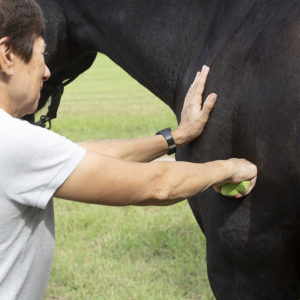Equine Massage Theory & Benefits
So much to learn, so little time! Equine massage is a wonderful addition to any horseman’s skill set. Whether you want to start a professional massage business or increase your own horse’s range of motion and performance we encourage all levels through our training, theories and benefits.
Massage has been around since the beginning of time in one form or another. An important aspect of our theories is to pay homage to the pioneers that have paved the way for the successful equine massage therapy practitioners we see today.
The massage therapist, in conjunction with a team approach of: vet, trainer, farrier, dentist, saddle fitter, chiropractor and acupuncturist (the list goes on) is striving to achieve the most comfort and homeostasis in the horse. This can and will, usually result in increased performance and recovery, overall sense of well being, a chance to develop more symmetrically, and hopefully cost less to support with proper maintenance.
We find it extremely important to stay current with techniques offered and today, there are many things:
Sports Massage
 According to Jack Meagher is to locate, treat and use follow-up exercise specific stress points in the muscle. The points are located in the musculotendinous junction of the origin of the muscle. They are mapped out in a systematic architectural sense. The origin is the anchored section of the muscle thus enduring the most stress. The point is located and treated with direct pressure, friction and compression techniques.
According to Jack Meagher is to locate, treat and use follow-up exercise specific stress points in the muscle. The points are located in the musculotendinous junction of the origin of the muscle. They are mapped out in a systematic architectural sense. The origin is the anchored section of the muscle thus enduring the most stress. The point is located and treated with direct pressure, friction and compression techniques.
Although this method is considered ‘archaic’ by many of the newer therapists, we believe that they do not truly understand what Jack was teaching. Although we still employ many modalities, this is still the basis of our work that has been successful for decades.
Myofascial Release
Myofascial release is definitely the most popular and undoubtedly the most researched method being used today. There are many aspects and approaches to myofascial work. We can find many PhDs that are now scientists devoted to discovering the mysteries of fascia. Many of these men and women were Rolfers (myofascial practitioners) at one time. The findings grow exponentially every year.
Pressure can vary from light to deep or slow to rapid. The goal is to affect the mechanoreceptors, thermoreceptors and neuroreceptors. These receptors are found throughout the skin, fascia, muscle, joint capsules etc.
Equine Fascial Energetics
Equine Fascial Energetics is an application that addresses the well-being of the horse while addressing the myofascial system. This is generally a slow, lighter approach that works with the electrical and energy fields in the body. The practitioner can expect the horse to experience ‘releases’ of tension, relaxation, homeostasis and an overall better balance in the body.
These are only a few of the methods used today and only a few of the techniques we explore in the Equine Massage/Muscle Therapy Certification Program.
Mike Scott, LMT, CSF | Equine Therapist & Saddle Fitter
If you’d like to know more about our classes please CLICK HERE.
Our DVDs go into the specific techniques that help your horse enjoy his life and perform better. CLICK HERE to shop our store.
